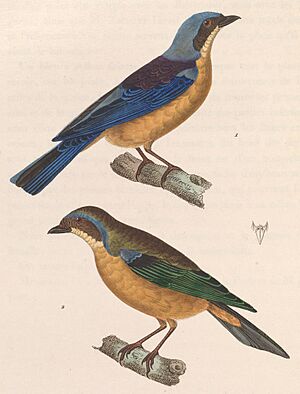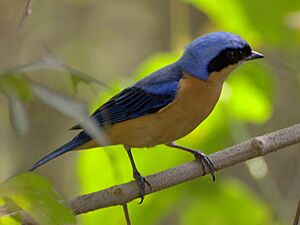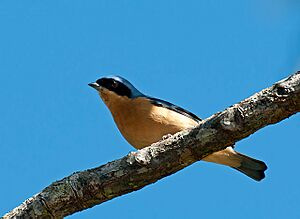Fawn-breasted tanager facts for kids
Quick facts for kids Fawn-breasted tanager |
|
|---|---|
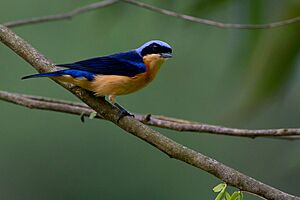 |
|
| Conservation status | |
| Scientific classification | |
| Genus: |
Pipraeidea
|
| Species: |
melanonota
|
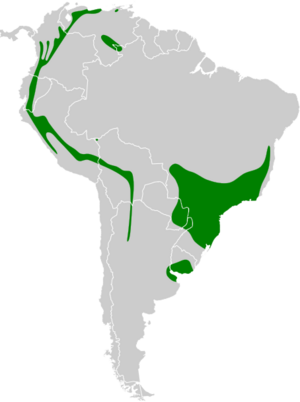 |
|
The fawn-breasted tanager (Pipraeidea melanonota) is a colorful bird known for its striking blue head and yellow chest. You can find this bird living in the Andes mountains across countries like Argentina, Bolivia, Colombia, Ecuador, Peru, and Venezuela. It also lives in the highlands of northeastern Argentina, southern Brazil, Paraguay, and Uruguay.
Contents
About the Fawn-breasted Tanager
Scientists give every living thing a special two-part name. This helps everyone around the world know exactly which animal they are talking about. The fawn-breasted tanager was first described in 1819 by a French bird expert named Louis Pierre Vieillot. He gave it the name Tangara melanonota. The name melanonota comes from old Greek words meaning "black back."
Later, an English naturalist named William Swainson gave it its current group name, Pipraeidea, in 1827. This name combines an older bird group name, Pipra, with a Greek word meaning "form" or "likeness."
Scientists have recently found that this tanager might be closely related to the blue-and-yellow tanager.
There are two main types, or subspecies, of the fawn-breasted tanager:
- P. m. melanonota: This type lives in open areas like forest edges and fields in southeastern Brazil, eastern Paraguay, and northeastern Argentina.
- P. m. venezuelensis: This type lives on the slopes of the Andes mountains in Venezuela, Colombia, Ecuador, Peru, Bolivia, and northeastern Argentina.
What Does It Look Like?
The fawn-breasted tanager is about 14 centimeters (5.5 inches) long. It usually weighs between 18 and 25 grams (0.6 to 0.9 ounces). This bird has a unique, short, wide beak, which looks a bit like a swallow's beak. It also has short legs and tail, but long wings.
The most noticeable part of this bird is its bright sky-blue head, or crown. It also has a wide black mask that goes over its eyes and covers its ears. Male birds have a medium blue color on their head and neck. Their forehead, area around the eyes, and ear covers are a deep black. The back of the male is a dull blue, but its lower back and rump are a bright turquoise-blue. Its tail is a dusky blue, and its throat and belly are a cinnamon color. The bird's eyes are dark red or reddish-brown, and its beak is dark with a gray lower part.
Female fawn-breasted tanagers look similar to males but are usually not as brightly colored. Their blue crown might be duller, and their back often has a brownish color. Young birds are mostly plain and have a dull brownish-gray color.
You'll usually see fawn-breasted tanagers alone or in pairs. They often perch in semi-open areas, but they can be found at any height.
Their calls sound like "see" or "swee" notes. They might sing 4 or 5 notes slowly, or a faster, pulsing trill with about a dozen notes.
Where Do They Live?
The fawn-breasted tanager lives across a large part of South America. Its home includes most of Brazil, Venezuela, Colombia, Peru, Ecuador, Bolivia, eastern Paraguay, Uruguay, and northeastern Argentina. It also follows the southern bank of the Río de la Plata.
These birds like to live in places where forests meet open areas. They can be found in bushy pastures, and small cultivated areas with big trees and clearings. The height at which they live changes depending on the region. In the Andes and Ecuador, they live at altitudes of 1,500 to 2,500 meters (about 4,900 to 8,200 feet), sometimes even up to 3,000 meters (about 9,800 feet). In Colombia, they can be found as low as 900 meters (about 3,000 feet), and in Venezuela, down to 400 meters (about 1,300 feet).
What Do They Eat?
The fawn-breasted tanager eats a mix of different foods. They enjoy plant matter like berries, fruit pulp, buds, flowers, and seeds. They also eat insects such as moths, butterflies, or their larvae.
Sometimes, these birds join groups of different bird species to find food. They have also been seen gathering at fruit trees with other birds. However, they usually prefer to feed alone.
Reproduction and Migration
The fawn-breasted tanager moves around during different seasons. This is called seasonal migration. For example, you can find them in northern Venezuela from January to June. This is thought to be their breeding season. They are present in Pacific Colombia from November to March. Birds living in southern regions, like southern Argentina, might fly to warmer northern places during the coldest months.
These birds build neat, cup-shaped nests. They use materials like moss, small sticks, grass, straw, and even colored threads. They usually build their nests on the edges of pine branches in forest borders, about 15 to 20 meters (about 49 to 66 feet) off the ground. The nests are hidden with plants like epiphytes and mosses.
We don't have a lot of detailed information about their specific breeding habits. However, we do know that females lay 2 to 3 eggs. They sit on the eggs, or incubate them, for 12 to 14 days. Once the chicks hatch, they stay in the nest for about 18 to 22 days before they are ready to fly.
Conservation Status
The fawn-breasted tanager is currently listed as a "Least Concern" species by the IUCN. This means that scientists are not worried about this bird becoming endangered. It has a very large range, lives in many different types of habitats, and seems to have a large population. In fact, because people are opening up more forested areas for farming and other activities, this bird might even be spreading to new places.



